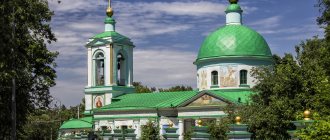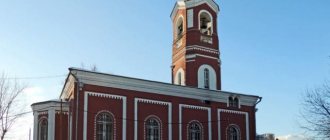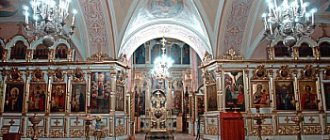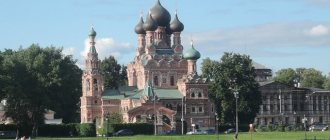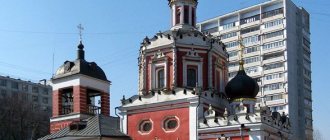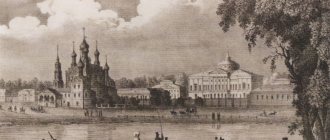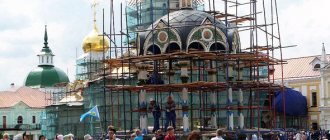| Church of the Holy Life-Giving Trinity (“Kulich and Easter”). Saint Petersburg |
Church of the Holy Life-Giving Trinity (“Kulich and Easter”)
(St. Petersburg Diocese)
- Address: Russia, 193012, St. Petersburg, Obukhovskaya Oborony Ave., 235 (metro station “Proletarskaya”)
- Telephone
- On the map: Yandex.Map, Google map
The territory where the temple is now located belonged to Prince Alexander Alekseevich Vyazemsky in the 18th century.
The prince was the director of the Imperial Porcelain Factory, which stood on the Shlisselburgsky tract (now Obukhovskaya Oborona Avenue). Here, next to the plant, he set up his residence - the Aleksandrovskoye estate. One day, Vyazemsky received a gift from Empress Catherine II - 200 thousand rubles. In memory of this event, he decided to use this money to build a temple in his estate park. On the facade of the church you can still see the inscription “In memory of your generosity. Started in 1785." The prince entrusted the implementation of the idea to the architect N.A. Lvov, a famous master of Russian classicism.
The temple, which once stood in the park of the estate, has the appearance of a rotunda, surrounded on the outside by Ionic columns, decorated inside with white Corinthian pilasters, and the bell tower is in the form of a tetrahedral pyramid, with a baptismal chapel on the first and a belfry on the second tier. The round church room seats about 800 people.
| Bell tower of the Church of the Holy Life-Giving Trinity (“Kulich and Easter”). Saint Petersburg |
This unique form of the temple is explained as follows.
The customer, Prince Vyazemsky, was the Prosecutor General and therefore, according to the plan of the project architect, the rotunda symbolizes the temple of justice, and the “solid prismatic pyramid” - “the unshakable aggregate... of three virtues”: Truth, Philanthropy and Conscience, i.e. symbol of the Mirror of Peter I. For its unusual appearance, the temple was popularly nicknamed “Kulich and Easter”. The construction of the church was carried out in 1785-1787, consecration in the name of the Holy Life-Giving Trinity took place on May 13, 1790.
In 1857–1859, a sacristy, a vestibule, two chapels and a fence were added to the church, which somewhat violated the original compositional plan; in 1905 the throne was decorated with marble and inlaid clothing.
Since 1871, the church operated a guardianship for the poor with a school and an almshouse. At the temple there was a cemetery with the Assumption Church.
In 1913, the “Children's Union” was created for children: children aged 6–14 years old gathered here twice a week - for prayers and conversations.
Since August 16, 1931, the building of the still functioning church was under the protection of the Glavnauka as an architectural monument of the first category.
In March 1938, by decision of the Leningrad City Executive Committee dated February 2, 1938, the church was closed. All church valuables, including the main shrine - the icon of the Holy Trinity [1], were confiscated and then disappeared without a trace. The building was recognized as a “monument of all-Union significance,” under state protection, and was used as a club and library.
The Council for the Affairs of the Russian Orthodox Church under the Council of People's Commissars of the USSR for Leningrad and the region approved the decision of November 17, 1945 to open the Kulich and Easter Church for worship. However, the district executive committee did not allow this to be done. And only after the petition of Metropolitan of Leningrad and Novgorod Grigory (Chukov) to the Chairman of the Leningrad City Council P.S. Popkov, the secretariat of the Leningrad City Council gave a second instruction to the Volodarsky district executive committee not to interfere with the opening of the church. After which the renovation of the temple building was resumed, and Trinity Church was opened to believers on April 17, 1946.
Story
On May 13, 1828, the sound of bells announced the construction of a new church in honor of the Holy Life-Giving Trinity
The temple was erected in honor of the Life Guards of the Izmailovsky Regiment. It was formed on September 22, 1730 by decree of Empress Anna Ioannovna. The emperor's military formation did not have its own temple, so the soldiers had to visit other parishes. In the early autumn of 1732, a portable church was brought to St. Petersburg , it was assembled and consecrated. It was a “seasonal church” on the banks of the Fontanka, and with the arrival of cold weather it was dismantled again.
Ten years later, a wooden church was built in its place , but it was small for the large number of parishioners. In 1752, the regiment submitted a petition to Empress Elizabeth Petrovna about the need to build a new church. It was built over two years, but during the flood of 1824 it was damaged and could not be restored.
The decision to build a stone church on the site of a destroyed wooden one was made by Nicholas I. According to his order, the temple premises were supposed to accommodate up to three thousand people. Nicholas I, architect V.P. Stasov and engineer P.P. Bazin took part in the construction. The process moved slowly, as every decision was agreed upon with the emperor.
The first stone of the Holy Trinity Monastery was laid on May 13, 1828 , on the feast of Pentecost. The cathedral an expensive seven years to build and was second in size only to St. Isaac's Cathedral, which was already under construction in St. Petersburg at that time. The cathedral was consecrated on May 25, 1835 on the eve of the Holy Trinity.
The emperor was dissatisfied with the wall paintings and the iconostasis, and twice asked to replace everything, but despite this, the temple seemed very light and spacious. The main shrines of the temple were considered: the image of the Resurrection of Christ, the icon of the Dormition of the Mother of God and the icon of the Mother of God “Joy of All Who Sorrow.”
Despite the fact that the temple was a regimental one, the number of civilian parishioners here increased every year. F. Dostoevsky married A. Snitkina here, and the funeral service of the greatest composer A. G. Rubinstein was also held within its walls.
Soviet time
The fate of the Holy Trinity Izmailovo Cathedral changed dramatically with the advent of Soviet power . The cathedral was turned into a regular parish church , and the regiment to which it belonged was disbanded.
On March 15, 1922, during the Divine Liturgy, with a large crowd of parishioners, the new “reformers” demanded that Archpriest Mikhail Cheltsov hand over the main values of the temple. They received a firm refusal from both the rector of the temple and his parishioners, and fearing “big blood” they retreated.
A month later, Father Mikhail was forced to sign a decree on the transfer of church valuables. The parishioners did their best to collect money and managed to buy out most of the property and the shrine. In total, the Bolsheviks took about 2 kilograms of gold and 300 kilograms of silver from the temple. In 1932, the Bolsheviks decided to completely destroy the cathedral , wiping it off the face of the earth. In its place they planned to build a club for workers. Thanks to numerous requests from parishioners, the All-Russian Central Executive Committee temporarily left the cathedral active. In 1939, the temple building was transferred to the theater. Lensovet for a workshop.
The revival of the cathedral began only in 1990-2000, before which there were periodic reports of theft, acts of vandalism and minor damage over time.
Fire
In 2006, a fire that started on the scaffolding of the Holy Trinity Izmailovo Cathedral destroyed the world's largest dome with a wooden base. The firefighters who arrived at the scene of the tragedy were unable to cope with the flames. The fire rose to a height of more than 100 meters, destroying not only the dome, but also the attic floors. The cause of the fire has not been established. The Divine Liturgy in the church began the next morning , but no longer under the dome of the church, but in the open air.
Clergy
Abbots
- Ilya Petrov (1790 [2] - 1806)
- Mikhail Dobronravin (1806 - 1810)
- Nikita Orlovsky (1818 - 1822)
- Pyotr Vinogradov (1822 - 1828)
- Smirnov (? - 1835)
- Matthiy Tsvetkov (1837 - 1851)
- Pavel Strelinsky (? - 1872)
- Vasily Kitaev (1872 - 1911)
- Ioann Kolesnikov (April 25, 1911 - September 29, 1915) [3]
- Nikolai Klerikov (1915 - 1917)
- Vladimir Bazaryaninov (1919 - 1924)
- Mikhail Vertogradsky (1924 - 1928)
- Vasily Spiridonov (1935-1936)
- Leonid Dyakonov (1936 - 1938)
- Mikhail Smirnov (1946 - 1947)
- Nikolay Lomakin (1947 - 1948)
- Ioann Ptitsyn (1948 - 1949)
- Modest Lavrov (1949 - 1952)
- Feodor Tsybulkin (1952 - 1963)
- Andrey Krylov (1963 - 1973)
- Victor Golubev (1973 - to present)
Priests
- Vasily Lebedev (1897 - 1904)
- Nikolai Uspensky (1904 - 1916)
Deacons
- Vasily Lebedev (1895 - 1897)
- Feodor Kemetsky (1897 - 1916)
- Ioann Alexandrov (? - 1937)
Architecture
Izmailovsky Cathedral is a large building with five domes , built in the Empire style. Its height is more than 80 meters. On the facades there are six-column porticoes, in the niches there are figurines of angels made of bronze.
In 1836, marble plaques with the names of officers who died in the battles of Austerlitz, Kulme and Friedland were hung on the walls. The main dome of the cathedral is visible from anywhere in the city at a distance of 20 kilometers.
Tradition says that the blue color of the domes was chosen according to the color of the Izmailovo uniforms
Interior decoration
Inside, the Izmailovsky Cathedral is bright and spacious. The main dome of the cathedral is raised up by four Corinthian columns, it seems to be floating in the air. Turkish banners hung on the walls of the cathedral, reminding of victory in the war with God's help. In 2005, the Column of Glory was restored in front of the shrine, the basis of which is captured Turkish cannons.
Used materials
- Historical information from the site Monasteries and Temples of the North-West
- Article from the site Walking around St. Petersburg
- Article from the Encyclopedia "St. Petersburg"
- Information about the clergy from the A.A. website Bovkalo
[1] It was donated by the peasants of the village of Aleksandrovskoye in 1824, and subsequently decorated with a silver-gilded chasuble.
[2] Popov I.V., Holy Trinity Church (“Kulich and Easter”),
[3] Trinity Church “Kulich and Easter”. Rectors of the church, website of the historical, architectural and landscape museum “Tula Necropolis”,
Sunday School
In a small 2-story building next to the temple there is a Sunday school for children and adults.
Sunday classes schedule:
| Group | Age of listeners | Class hours |
| Junior | From 3 to 7 years | 11-30 – 14-00 |
| Older | From 7 to 17 years | 12-00 – 14-00 |
| Youth | From 17 to 35 years old | 14-00 – 15-00 |
| Adult | Over 35 years old | 16-00 – 17-00 |
School education is free. Students study the Law of God and the Fundamentals of Worship, Moral Theology, Lives of Saints. They engage in literary reading, applied arts and choral singing. The school regularly hosts reading competitions, festive theatrical performances, and exhibitions. Children and adults take part in worship services and sing in the church choir.
How did such a unique church come into being?
Trinity Church was opened in 1787 on the territory of the Alexandrovskoye estate, which belonged to Prince A. A. Vyazemsky. One day, Catherine II made a generous gift to her court nobleman - two hundred thousand rubles. The prince used this money to build a temple for the parishioners of his estate. There is still a plaque on the wall of the church testifying to this fact. The inscription on it reads: “In memory of your generosity.”
But initially the idea of giving the temple such forms was not connected with Easter dishes. According to the plan of the customer, who served as the Prosecutor General, and the architect N.A. Lvov, the rotunda was supposed to personify the temple of the law, and the ancient image of the pyramid was the totality of human virtues.
The Church of the Holy Trinity of the Life-Giving is also famous for the fact that it was active almost constantly. In its entire history, it was closed for only eight years, from 1938 to 1945. During these difficult war times, a club located nearby operated in the church.
Parish and choir of the temple
The parish of the temple numbers several dozen believers who actively participate in divine services, festive prayer services and processions. They carry out traditional subbotniks to clean the temple and put the area around it in order: they paint benches and borders, whitewash tree trunks, clean lawns. On the days of the main divine holidays, believers organize festivities at the temple, games and round dances with children from the Sunday school. Young people are engaged in volunteer work.
Pilgrimage trips of parishioners to holy places have become a good tradition. Photos and video materials about them are published on the parish website. The church amateur choir consists of parishioners. The theater studio puts on performances based on religious themes. In January 2022, the first printed issue of the Parish Newspaper was published, which now covers the life of the parish in monthly issues, publishes schedules of services, as well as educational articles on religious topics. There is an account on social networks.
Fire in Trinity Cathedral
On August 25, 2006, a massive fire broke out at Trinity Cathedral, destroying Bazaine's original 170-year-old central dome. The fire started from scaffolding around it. The blaze quickly spread to the attic space. As a result, the outer structures of the dome collapsed onto the inner brick vault, which, fortunately, did not collapse, despite the fact that it was very hot. In addition to the main dome, four small ones were also damaged in the fire, which by that time had been completely restored.
Immediately after the fire was extinguished, a fundraiser was announced for the restoration of the damaged cathedral. Already in the first two months, more than 6 million rubles were received from ordinary individuals and organizations. The head of the Roman Catholic Church, Benedict XVI, also contributed, donating 10 thousand euros to the St. Petersburg church.
Years later, a fire in the legendary Notre-Dame de Paris developed according to a similar scenario.
Revival of the temple
Late 20th century
Since the 90s, the spiritual life of the famous cathedral of the Life Guards Izmailovsky Regiment has been revived. On the initiative of the intelligentsia of the Northern capital and with the blessing of Metropolitan John (Snychev), the Orthodox community begins to operate here.
On the day of the celebration of the Vladimir Icon of the Mother of God, September 8, 1990, the first liturgy was served in the church. The city government returned the cathedral (or rather, the damp walls remaining from it) to the St. Petersburg diocese, and the Parish Council set about reviving the desecrated church. I note that the basements were so flooded with water that, according to eyewitnesses, it was possible to sail boats in them. Along with the reconstruction of the building, prayer did not stop, although in winter the priests’ hands sometimes froze to the liturgical vessels. But the general joy of the renovation of the temple was no longer overshadowed by any difficulties.
Icons and church utensils were transferred here from the Museum of Religion and Atheism. Ordinary people also brought relics. The Alexander Nevsky Chapel, returned to the cathedral in 1991, was restored by November 26, 1998.
Past pious customs were gradually revived. So, in 1993, the Society of St. John the Warrior appeared at the temple, which was joined by officers of the Russian army. Bishop John (Snychev) himself became rector of the cathedral in 1994.
After his death, in 1996, Archpriest Gennady Bartov was appointed to take the place of the head of the church and the parish council. From that moment on, on the patronal holiday - the Day of the Life-Giving Trinity - bishop's services began to be held.
Despite the difficulties of restoring the building, the priests of the temple immediately begin active public work. They feed the community of the orphanage, the parishioners of the house church of psychiatric hospital No. 5, and the house church of the Cadet Missile and Artillery Corps.
The parishioners of the cathedral also helped restore my beloved Vvedeno-Oyat convent in the Leningrad region, which is famous for its miraculous spring.
I will also mention to you that during the renovation, a “Slavic Hall” for meetings with soldiers and an art workshop appeared in the basement.
Life of the Trinity-Izmailovskaya Church in the 21st century
I want to continue the story by saying that in 2003, Russian President V.V. Putin himself donated to the cathedral the icon of the Russian masters “The Holy Trinity” (15th century). This image is now especially revered. Another extraordinary event for the temple and St. Petersburg happened in 2005. In October, the recreated “Military Glory” column was solemnly consecrated by Metropolitan Vladimir.
On that day, a solemn ceremony took place with the participation of military units, which was as close as possible to the protocol of the 1886 parades. I cannot express in words the feeling when you yourself are a real witness to the return of the former glory of your country.
Now, every year since 2003, the Izmailovsky Cathedral has held a choir competition and concert events during Holy Week (the first week after Easter).
An orphanage appears again under the patronage of the temple.
Good deeds are often tested for endurance. A new severe test for the Izmailovo Church was a large-scale fire on August 25, 2006. I remember this day well.
The burning central dome could be seen from a long distance. The cause of the fire, which occurred during the evening service, remains unknown. But I want to tell you that that service was not interrupted, but ended only with reductions permitted by the charter. Through the joint efforts of the city, the fire was stopped.
But Bazin's famous dome burned to the ground, and the interior was also heavily damaged due to the water used to extinguish the flames. And it was here that the resilience and unity of the clergy, parishioners and the entire city manifested themselves. The next day, while the firefighters were still working, the liturgy was again heard right on the porch of the cathedral.
And in all subsequent years, despite ongoing repairs, services did not stop. The cathedral was restored, as they say, by the whole world, even from abroad a significant amount was donated for these purposes.
The process of restoring the architectural masterpiece was supervised by the government of St. Petersburg. On a fine day, October 9, 2008, a 9-meter cross was finally solemnly raised onto the main dome.
This is the “twin” of its predecessor, who headed the temple since 1835.
Shrines of the modern cathedral
In parallel with the restoration work, new shrines constantly flocked to the temple, including particles of the relics of Saint Matrona of Moscow, Peter and Fevronia (they pray to them for marital well-being), Basil the Great, John Chrysostom, Gregory the Theologian and others.
If you wish, I invite you to familiarize yourself in more detail with the shrines that you can see in this church today. For me, what is especially dear to me is the particle of the relics of Matronushka of Moscow, this glorious intercessor of the Russian land.
I was very happy to visit the Intercession Monastery in Moscow several times, where the saint rests. And now St. Petersburg residents come here to worship her, to the temple of their city.
Interior decoration
The beautiful and solemn decoration of the temple makes a strong impression on believers. After the revolutionary events of 1917, the church premises were taken under the protection of the workers' and peasants' state in August 1931, then the religious complex was recognized as a monument of all-Union significance. Since 1938, it was briefly occupied by cultural institutions.
Thanks to this, the interior decoration of the building was not damaged. The original stucco molding and some frescoes have been preserved. The blue walls of the round hall are decorated with beautiful traditional decor in the form of pilasters with capitals (imitation columns).
In the upper part of the altar arch (apse), flying angels support on both sides the ancient cult symbol “The All-Seeing Eye,” which is not only revered in Christianity, but is also used by Freemasons. The sky-colored dome and the centuries-old atmosphere evoke in parishioners a sense of reverence and a sense of divine grace.
Majestic beautiful iconostasis of the 18th century. was transferred from the St. Petersburg Annunciation Church. The rest of the decoration and utensils are of later origin.
Description
The Holy Trinity Cathedral in St. Petersburg is located on Izmailovsky Prospekt near the Fontanka River in a small square surrounded by urban buildings. On the vast territory between modern Moskovsky and Izmailovsky Avenues, between the embankment of the Fontanka River and Zagorodny Avenue, the barracks of the Imperial Life Guards Izmailovsky Regiment, formed by decree of Empress Anna Ioannovna in 1730, were located by company. The majestic white-stone temple, its five domes, covered with blue paint and a scattering of gold stars on high drums with semi-circular windows, are visible from many parts of the city. The cathedral on Izmailovsky Prospekt is a visible witness to the military history of Russia.
Information for pilgrims
The special pilgrimage service “Cathedral” will help you make a pilgrimage trip to St. Petersburg: transport is provided, the services of an experienced guide are provided, accommodation in your own hotel at affordable prices, 2 meals a day.
A group or individual trip to the northern capital according to a standard or customized pilgrimage program can be arranged online through the Cathedral website, as well as by phone, or through the WhatsApp/Vieber applications (tel.). The approximate price of a trip for 1 person for 2 days will be from 5,500 rubles, for 5 days - from 12,500 rubles.
History of the Holy Trinity Cathedral in the 20th century
After the decree of the Soviet government was issued in 1918 on the separation of Church and state, the status of the temple from a regimental cathedral turned into an ordinary parish church. The Izmailovsky regiment and the regimental clergy were gone. The new authorities sought to destroy the Church as an institution. Religious societies were prohibited from owning property, educating children, and having rights to property. Widespread expropriation of church property began. In 1922, a commission to confiscate valuables also came to the Trinity Cathedral. In total, about 2 kg were taken out. gold and 300 kg. silver Persecution of clergy began. In 1922, the Bolsheviks arrested Metropolitan Veniamin of Petrograd and Gdov, the rector of the Trinity Cathedral, Archpriest Mikhail Cheltsov, a total of 86 people. Most of the clergy were convicted and sentenced to prison. Vladyka Veniamin was shot. Father Mikhail, upon his release, was assigned to the Church of the Resurrection of Christ in Kolomna.
In 1925, the banners of the Izmailovsky regiment, military trophies obtained in the wars with Turkey, and memorial marble plaques were knocked down from the Trinity Cathedral. In 1928, the “Military Glory” column, as a “symbol of Russian militarism,” was dismantled, and the captured guns surrounding it were destroyed.
The 30s of the 20th century became especially difficult for the clergy of Trinity Cathedral. Accused of counter-revolutionary agitation, the rector of the Trinity Cathedral, Archpriest Mikhail Cheltsov, Metropolitan Seraphim of Leningrad and Gdov, and Bishop Ambrose were shot. In 1933, the Trinity Cathedral in the Alexander Nevsky Lavra was closed. The Leningrad diocese was headed by Patriarch Alexy I. He gave the Holy Trinity Cathedral the status of the Cathedral of the Most Holy Trinity, but in 1938 the temple was closed.
During the Great Patriotic War, a bomb shelter was built in the basements of the Trinity Cathedral; soldiers from a nearby anti-aircraft battery lived there. After the war, Trinity Cathedral was a sad sight. There were unheated warehouses in the temple, and the building fell into disrepair. The first post-war restoration was carried out in 1952-1956.
In 1994, under the rector of the Holy Trinity Cathedral, Metropolitan John, the Orthodox community was again formed. Colossal work has begun to bring the Orthodox church back to life. In 1996, Metropolitan Vladimir appointed Archpriest Gennady Bartov as rector of the Holy Trinity Cathedral. In 1997, the tradition of all-night vigil and bishop's services on the Patronal Feast of the Most Holy Trinity was established.

